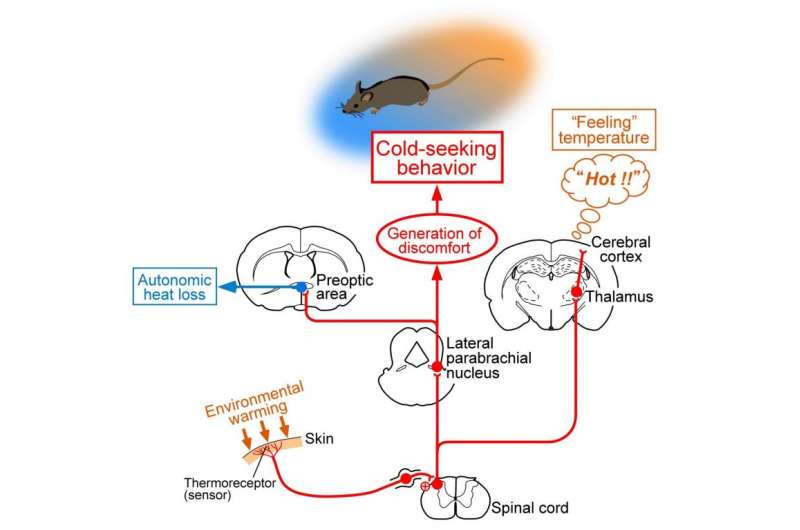Different sensory pathways engaged in feeling and responding to external temperature

To maintain the body at an appropriate temperature despite changes in the environment, there are a number of physiological and behavioral responses that can be adopted, such as shivering or moving into or out of direct sunlight. Although these responses are well understood, there is still a lack of understanding of the nerve and brain pathways that control them.
Researchers at the Department of Integrative Physiology at Nagoya University Graduate School of Medicine have boosted our knowledge of sensing external temperature and responding to it to maintain body temperature, known as "thermoregulation," by disabling parts of the brain in rats and then observing the animals' choices of a comfortable environmental temperature. The new findings, recently published in Scientific Reports, could also help us understand conditions in which these regulatory systems go awry, such as heatstroke.
The team built on earlier studies that suggested the involvement of two brain/neural sensory pathways in thermoregulation, namely, the spinothalamocortical (STC) pathway and the lateral parabrachial nucleus-hypothalamus preoptic area (LPB-POA) pathway. They injected toxic substances into parts of the brain involved in each of these pathways to disable them, and then investigated how this influenced the "feeling" of temperature changes and responses to such changes.
"We tested the thermal responses of rats using an arrangement with two floor plates of different temperatures," Takaki Yahiro says. "In control conditions, the rats preferred to stay on the 28°C plate, rather than the 15°C or 38°C one." He adds, "When we injected a toxin into part of the brain involved in the STC pathway, surprisingly, we found that the rats still showed this temperature preference, even though they had lost their ability to 'feel' temperature in the primary somatosensory cortex."
However, when part of the LPB pathway was instead disabled by injecting another toxin, the rats no longer tried to avoid the hot and cold plates. Measuring their body temperature also revealed that their brains had warmed up to a hyperthermic state when they had been on a warm plate, showing that the body's ability to regulate its core temperature had been damaged.
"These findings show the different functions of these two sensory pathways in 'feeling' external temperature changes and in actually responding to these changes behaviorally," Kazuhiro Nakamura says. "We can now pursue a much better understanding of the circuits that control thermal comfort and how these help the temperature of the body to be maintained."
The team hopes to build on this work by obtaining detailed findings on the specific groups of neurons involved in the pathways and on the involvement of emotion-related parts of the brain in thermoregulation and the behavior of seeking thermal comfort.
More information: Takaki Yahiro et al. The lateral parabrachial nucleus, but not the thalamus, mediates thermosensory pathways for behavioural thermoregulation, Scientific Reports (2017). DOI: 10.1038/s41598-017-05327-8




















